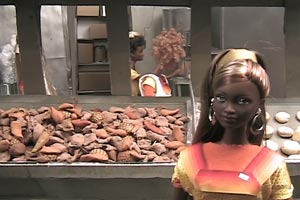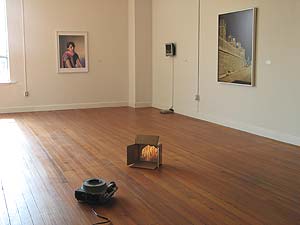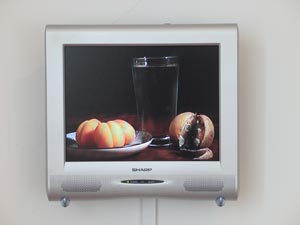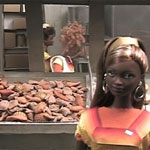Big Gurl is the centerpiece of the exhibition Lauren Kelley: Collect Them All! Soft Brown Narratives. This 12-minute video projection features African-American Barbie-style dolls filmed in a combination of claymation and stop animation.
Staging vignettes that are alternately clumsy and endearing, in sets that are as ingenious in their inventive simplicity as they are glossy and glib in their brightly colored, overlit presentation, Kelley seems intent on showing all the seams of her video making. Figures bend and move awkwardly; when giant beads of sweat overwhelm the fast food workers in one scene, Big Gurl's narrative seems ready to spin out of control. But if her technique is occasionally awkward, Kelley's voice is consistent and clear in addressing serious subjects, ranging from pregnancy to male chauvinism, self-image to the feminine mystique. Backing up Big Gurl, a series of moderately scaled digital prints considers dollhouse beauty from a more distanced point of view. My favorites, Close Up and Pool Scene, focus on individual figures and dispense with Big Gurl's veneer of jocular levity. Kelley uses the sharply planar focus on toys that was pioneered by David Levinthal as a scalpel to dissect the façade of beauty inherent in the impossible anatomy of these dolls and in the equally impossible aesthetic ideologies associated with them.
Any assemblage of 15 media artists promises to be a jittery show, especially one that cites Jean Baudrillard on its checklist. Lawndale's overbright third floor space is a difficult venue for light-sensitive works, and like most group shows, Impossible Exchange: New Lens Based Work From Texas assembles almost as many trends as it does artists. Organized by Lynne McCabe, chair of Lawndale's programming committee, it is worth checking out as much for the quality of the assembled work as for a report on how international trends in media art are being incorporated locally.
"Lens-based" is an all-encompassing definition for any art that takes light as its basic medium. McCabe's approach was decidedly full spectrum, juxtaposing three-dimensional works with still photography, slide projections, and both wall-mounted and projected videos. Barna Kantor's Processed Light II offers the most wide-ranging example: 48 small fans, double stacked floor-to-ceiling, have been mounted in front of a mirrored surface set deep within an architectural recess. Kantor's sculpture doubles as a diffraction grating as whirring fan blades set within their housings spin time into light, and the work's strong verticality endows it with the attributes of both a moiré pattern and a perspectival study. Processed Light II's opticality is a lot like a Bridget Riley painting — disorienting, but intoxicatingly so.
Opposing Kantor's light sculpture in attitude and gallery placement, Karen Mahaffy's Still Life with Fruit and Zhuang Zi takes on one of the older tropes in European art, the vanitas still-life. Unlike Sam Taylor-Wood's time-lapse photography videos of the same subject, which compress the still-life into a race between swirling flies and rampantly multiplying piles of mold (the winner is always the goo), Still Life with Fruit and Zhuang Zi takes the 'still" part of its subject seriously. Not very much happens here: ice in a glass shifts, melts, some water evaporates, and sliced fruit desiccates before molding slightly. The video's wall-mounted, flat-panel presentation plays further on the still-life tradition's painterly roots. Perhaps in homage to the Taoist philosopher mentioned in the title, the accompanying soundtrack of bird chirps and ambient background noises is a startlingly indeterminate imposition on such pronounced painterly references.
Mahaffay's sequencing of time's progress encapsulates two of the exhibition's dominant themes: painting-inflected media arts and a preoccupation with time. Andrea Caillouet, Amanda Moon and Andy Taylor take photography in the direction of painting. Caillouet's Portrait of a Landscape series offers a bug's-eye view of the world. Vertically oriented and brightly colored, these small photographs use planar focal points to monumentalize foregrounded blades of grass, while transforming middle and deep distances into an abstract blur. However, they are encased within heavy wooden frames typical of historically prominent art, which contradict the photographs" carefully ahistorical staging. Moon's acerbically titled color photographs Gin and Juice and 911 is a Joke monumentalize the wave patterns of tonal liquids in the manner of Gerhard Richter's microphotographs of mineral structure or Adam Fuss's experiments in out-of-camera photography. Taylor's What's Up with Smith, a painterly pigment transfer on W/C paper, forces a retro painting style onto a not particularly intriguing subject, reinforcing the difficulty of applying painting tactics in hope of photographic solutions.
Time-based considerations dominate Demetrius Oliver's untitled, floor-mounted slide projector, which projects a full carousel (80 slides) of images into a small cardboard box. Known for his color self-portrait photographs positioning the artist in a variety of humorous, awkward or demeaning situations, Oliver here presents one recurrent image — a bacon-wrapped fist made recognizable only by the artist's protruding thumb. This promises a nitrite-rich reincarnation of Carolee Schneeman's 1964 performance/film Meat Joy, but Oliver's success is with his presentation: his unblinking approach to his subject makes this a case where repetition does not make the heart grow fonder.
The show's three video projections also take sidelong glances at time-based issues. Rotem Balva's Sand Fight delivers the less than epic battle promised in its title while approximating the casual textures of a home movie. Duncan Ganley's KeflavÍk — The new film from acclaimed director Martin MacAnally goes in the other direction. Polished, precisely edited and ambiguous in content, this short film trailer continues the current artistic preoccupation with the movie trailer, a format most recently championed by Francesco Vezzoli in his bawdy, star-studded come-on for the fictional series Caligula. Stephanie Saint Sanchez's Ms. Pickle's 3rd grade class presents Death Penalty features the same kind of stop-action photography as Lauren Kelley's Big Gurl: these two shorts would make a great double bill. Sanchez uses close-ups and pan shots of colorful drawn or cutout figures to great effect. Like Kelley, her work before the camera starts shooting incorporates the handmade into video making in a way that meshes perfectly with her expressive storytelling purposes.
Difficult to see (a blackout curtain would have really helped), these projections are also burdened by their situation next to Jill Pangallo's Jimmy & Ireka Darlingan present Seduza!, an "erotically charged" faux infomercial featuring lip-synch singing, post-performance interviews and lots of bad acting. Verging on the well-trod territory of Mike Smith (whose TAKE OFF YOUR PANTS! was recently displayed at Dunn & Brown in Dallas), this video is backed up by all manner of accoutrements, from performance posters to image-emblazoned coffee mugs, postcards and mouse pads. Unfortunately, this is another case where production values trump content. The magic is really bad, even for kitsch parody, and Pangallo lacks Smith's ability to provoke pathos with a deadpan glance.
This is the second ambitious group show Lawndale has situated in its third floor gallery. The show provides a succinct introductory sampler of the lens-based community (with the notable exception of documentary or typological works), but it also suggests the kernel of an idea worthy of further exploration, perhaps in Lawndale's main gallery, with more artists and multiple examples to provide context. And as Lauren Kelley's show makes clear, the mezzanine gallery makes a perfect video lounge.
Images courtesy Lawandale Art Center and Lynn McCabe.
Christopher French is an artist and writer currently living in Houston. He is also a contributing editor of Glasstire.






